Front Suspension
The struts are shortened 510 struts with threaded spring seats. They also have a new flange to accommodate the Corvette brake caliper (see the brakes page). The front is softly sprung. I started off with 140-lb. springs, but they felt a little too soft, so I have switched to 165-pound springs. (The weight on the front wheels is very light for a 510.) Replacing the 10-inch Carrera springs with 8-inch springs allowed me to move the spring seat up on the strut about two inches, so I have a little more inside tire clearance (enough for 5 inches of wheel back spacing). This did reduce the ride height adjustability though - from the ride height shown in the pictures, the front can be raised over one inch but could not be lowered more than about another 1/2 inch. But actually that is not a problem, because the ride height is now right where I want it!
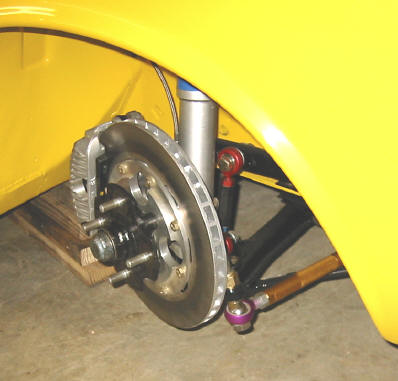
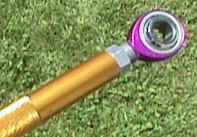 Also, I wanted a way to
adjust the bump steer on the front suspension, which generally requires spacers between
the steering knuckle and the tie rod. So to replace the stock tapered design with straight
bolts, I have assembled some tubular gold anodized aluminum steering arms with aluminum
rod ends and aluminum jam nuts. The entire assembly weighs only 12 ounces each!
Also, I wanted a way to
adjust the bump steer on the front suspension, which generally requires spacers between
the steering knuckle and the tie rod. So to replace the stock tapered design with straight
bolts, I have assembled some tubular gold anodized aluminum steering arms with aluminum
rod ends and aluminum jam nuts. The entire assembly weighs only 12 ounces each!

Some early experimental front suspension pieces, including the tubular
front sway bar and the unmodified aluminum arms (black pieces).

Completed tension rods
In order to have a caster adjustment, I have made some adjustable-length, lightweight tension rods. While working with the front suspension on the car, I noticed that the tension rod, when mounted to the frame of the car but not connected to the suspension at the other end, is very difficult to move up and down, especially with urethane bushings. Obviously this causes a lot of extra stiffness in the suspension without improving the handling. Stock bushings are not too bad, but they can deflect under braking and cornering, allowing an unwanted change in suspension geometry. I believe that using a rod end or mono ball where the tension rod connects to the frame, in addition to one where the control arm attaches to the front subframe, will free up the suspension significantly. Suspensions can best do their job (springs can best keep tires in contact with the road) when friction is minimal.
Turbo Tom was a big help to me in designing these tension rods. He taught me the importance of lack of friction in suspension pivots. In fact, the increased ride harshness that many people experience after installing an aftermarket sway bar is often due more to friction in the pivot bushings than to the stiffness of the bar itself. This is why serious race cars use bearings (or maybe bronze bushings) rather than tight nylon bushings.
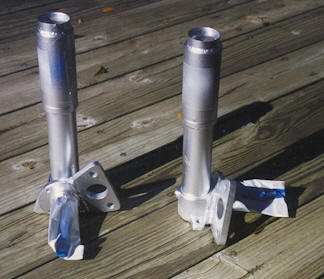
Bare struts
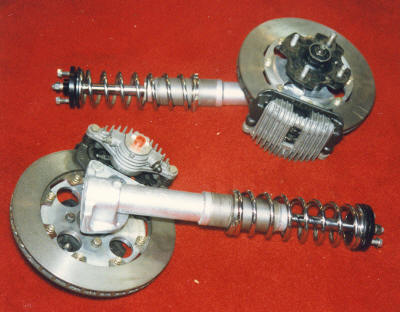
Assembled struts
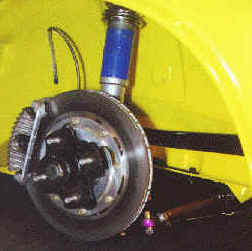
Installed struts
The front anti-roll bar did not turn out as I had originally expected. Since the chassis already had brackets for a Tilton sway bar welded to the frame where the sway bar normally mounts, I figured I would use the Tilton sway bar. In fact, that seemed like one of the easier and more obvious decisions. I knew that these sway bars had low ground clearance for street use, but this was going to be a very low car anyway, and only I would be driving it. However, the Tilton sway bar is not designed for use with a ball joint spacer ("bump steer" spacer), and using one would put the sway bar that much closer to the ground. (Tilton front sway bars go underneath the control arm.) The 1-1/8 inch sway bar interferes with the front crossmember, and the tension rods interfere with the sway bar mounts. So unfortunately, I won’t be able to use the Tilton sway bar. Oh well, a tubular bar with aluminum arms will be better anyway. Goes to show you. And I couldn’t use a normal aftermarket 510 sway bar because of the welded Tilton brackets. So I had to do something completely different: I used a straight, tubular, 1-1/4" bar with aluminum arms.
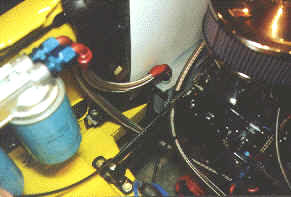 The
tubular anti-roll bar is much nicer
than what I had originally planned (the Tilton bar), because it is lighter, it is more
adjustable, and it doesn’t affect ground clearance. And since the arms and the end
links are much longer, the geometry is a lot better too. In this picture you can see
where the bar is mounted to the frame rail.
The
tubular anti-roll bar is much nicer
than what I had originally planned (the Tilton bar), because it is lighter, it is more
adjustable, and it doesn’t affect ground clearance. And since the arms and the end
links are much longer, the geometry is a lot better too. In this picture you can see
where the bar is mounted to the frame rail.